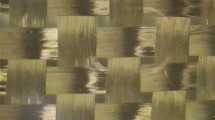Abstract
The global mechanical properties of textiles such as elasticity and strength, as well as transport properties such as permeability depend strongly on the microstructure of the textile. Textiles are heterogeneous structures with highly anisotropic material properties, including local fiber orientation and local fiber volume fraction. In this paper, an algorithm is presented to generate a virtual 3D–model of a woven fabric architecture with information about the local fiber orientation and the local fiber volume fraction. The geometric data of the woven fabric impregnated with resin was obtained by micron-resolution computed tomography (μCT). The volumetric μCT-scan was discretized into cells and the microstructure of each cell was analyzed and homogenized. Furthermore, the discretized data was used to calculate the local permeability tensors of each cell. An example application of the analyzed data is the simulation of the resin flow through a woven fabric based on the determined local permeability tensors and on Darcy’s law. The presented algorithm is an automated and robust method of going from μCT-scans to structural or flow models.















Similar content being viewed by others
References
Laessig R, Eisenhut M, Mathias A, Schulte R, Peters F, Kuehnemann T, et al.: Series production of high-strength composites: Perspectives for the German engineering industry. Roland Berger and VDMA. (2012)
Middendorf P, Metzner C. Aerospace applications of non-crimp fabric composites. In: Non-crimp fabric composites: Manufacturing, properties and applications, Ed.: Lomov, S. Woodhead Publishing in materials; Oxford and Philadelphia: Woodhead Pub; 2011
Skoeck-Hartmann B, Gries T. Automotive applications of non-crimp fabric composites. In: Non-crimp fabric composites: Manufacturing, properties and applications, Ed.: Lomov, S. Woodhead Publishing in materials; Oxford and Philadelphia: Woodhead Pub; 2011
Beier, U., Fischer, F., Sandler, J., Altstadt, V., Weimer, C., Buchs, W.: Mechanical performance of carbon fibre-reinforced composites based on stitched preforms. Compos. A: Appl. Sci. Manuf. 38(7), 1655–1663 (2007)
Bibo, G.A., Hogg, P.J., Backhouse, R., Mills, A.: Carbon-fibre non-crimp fabric laminates for cost-effective damage-tolerant structures. Compos. Sci. Technol. 58(1), 129–143 (1998)
Parnas, R.: Liquid Composite Molding. Hanser Gardner publications, Munich (2000)
Dumont, P., Vassal, J.-P., Orgéas, L., Michaud, V., Favier, D., Månson, J.A.-E.: Processing, characterization and rheology of transparent concentrated fibre bundle suspensions. Rheol. Acta. 46, 639–651 (2007)
Lai, C., Young, W.: Model resin permeation of fibre reinforcements after shear deformation. Polym. Compos. 18, 6428 (1997)
Smith, P., Rudd, C., Long, A.: The effect of shear deformation on the processing and mechanical properties of aligned reinforcements. Compos. Sci. Technol. 57, 327–344 (1997)
Zako, M., Uetsuji, Y., Kurashiki, T.: Finite element analysis of damaged woven fabric composite materials. Compos. Sci. Technol. 63, 507–516 (2003)
Bahei-El-Din, Y.A., Rajendran, A.M., Zikry, M.A.: A micromechanical model for damage progression in woven composite systems. Int. J. Solids Struct. 41, 2307–2330 (2004)
Pickett, A.K., Fouinneteau, M.R.C.: Material characterisation and calibration of a meso-mechanical damage model for braid reinforced composites. Compos. Part A. 37, 368–377 (2006)
Creech, G., Pickett, A.: Meso-modelling of non-crimp fabric composites for coupled drape and failure analysis. J. Mater. Sci. 41(20), 6725–6736 (2006)
Buet-Gautier, K., Boisse, P.: Experimental Analysis and Modeling of Biaxial Mechanical Behavior of Woven Composite Reinforcements. Exp. Mech. 41(3), 260–269 (2001)
Bayraktar, H.; Tsukrov, I.; Giovinazzo, M.; et al.: Predicting cure-induced microcracking in 3D woven composites with realistic simulation technology. Proceedings of Society for the Advancement of Material and Process Engineering (SAMPE) Conference (2012)
Zou Z, Zheng S, Cheng L, Xi B, Yao J: Effect of Some Variables on the Fibre Packing Pattern in a Yarn Cross-section for Vortex Spun Yarn. FIBRES & TEXTILES in Eastern Europe 2014, Vol. 22, No. 2(104): 40–46
Badel, P., Vidal-Sallé, E., Maire, E., Boisse, P.: Simulation and tomography analysis of textile composite reinforcement deformation at the mesoscopic scale. Compos. Sci. Technol. 68(12), 2433–2440 (2008)
Desplentere, F., Lomov, S.V., Woerdeman, D.L., Verpoest, I., Wevers, M., Bogdanovich, A.: Micro-CT characterization of variability in 3D textile architecture. Compos. Sci. Technol. 65, 1920–1930 (2005)
Latila, P., Orgéasa, L., Geindreaua, C., Dumontb, P.J.J., Rolland du Roscoata, S.: Towards the 3D in situ characterisation of deformation micro-mechanisms within a compressed bundle of fibres. Compos. Sci. Technol. 71(4), 480–488 (2011)
Fast, T., Scott, A.E., Bale, H.A., Cox, B.N.: Topological and Euclidean metrics reveal spatially nonuniform strure in the entanglement of stochastic fiber bundles. J. Mater. Sci. 50, 2370–2398 (2015)
Buzug, T. M.: Einführung in die Computertomographie, mathematische Grundlagen der Bildrekonstruktion. Springer-Verlag, Heidelberg (2004)
Image Processing Toolbox in MATLAB, Version 14.x from The MathWorks, Inc. Natick, Massachusetts, United States and elements of the included Image Processing Toolbox
Gebart, B.: Permeability of Unidirectional Reinforcements for RTM. J. Compos. Mater. 26, 1100-1133 (1992)
Darcy, H.: Les fontaines publiques de la Ville de Dijon. Dalmont, Paris (1856)
Datasheet for used resin: MGS® RIM 135 HEXION, 12/2006
nanotom® from the company phoenix|x-ray
Krieger, Helga.: Auf Computertomographiedaten basierte Strömungssimulation des Tränkverhaltens von Verstärkungstextilien; Diplomarbeit am Institut für Textiltechnik der RWTH Aachen, Aachen Juni 2010
Author information
Authors and Affiliations
Corresponding author
Rights and permissions
About this article
Cite this article
Krieger, H., Seide, G., Gries, T. et al. Geometrical analysis of woven fabric microstructure based on micron-resolution computed tomography data. Appl Compos Mater 25, 399–413 (2018). https://doi.org/10.1007/s10443-017-9626-4
Received:
Accepted:
Published:
Issue Date:
DOI: https://doi.org/10.1007/s10443-017-9626-4




